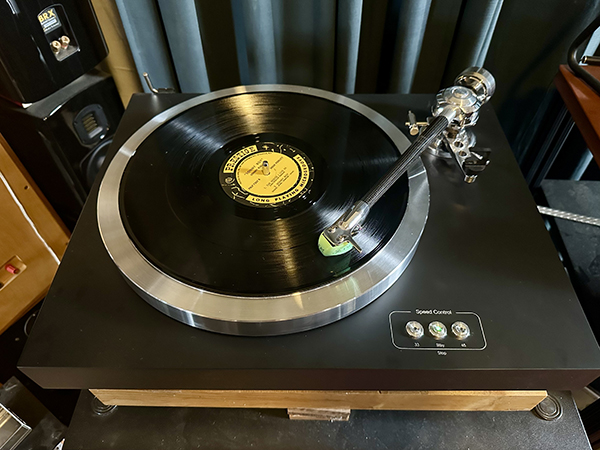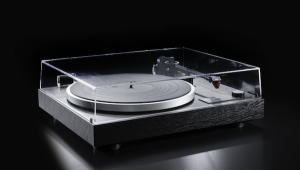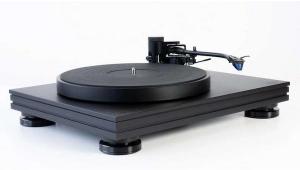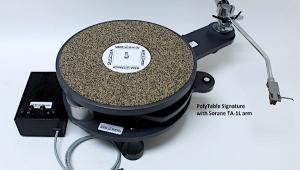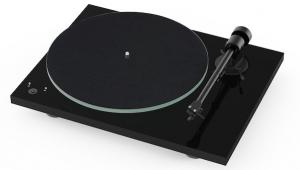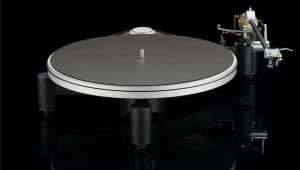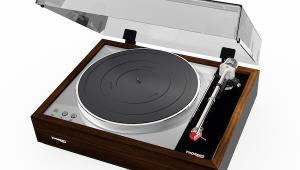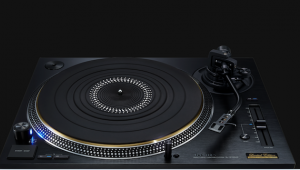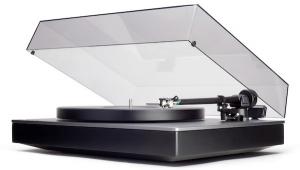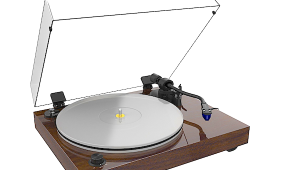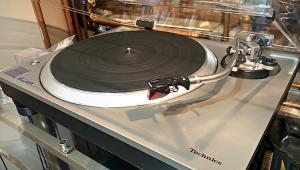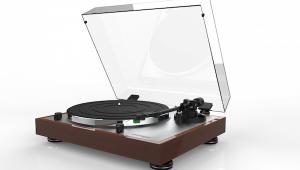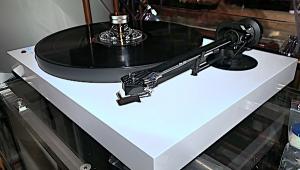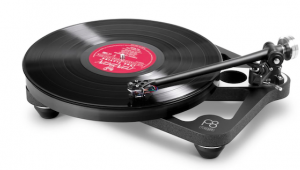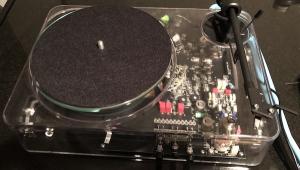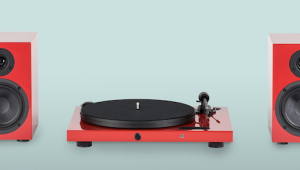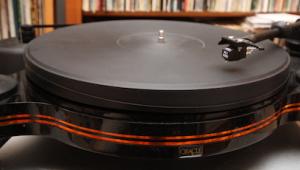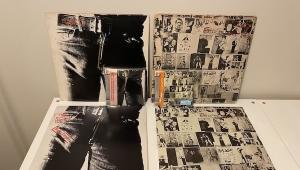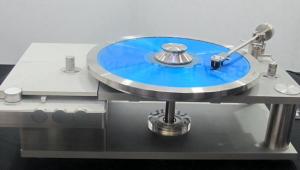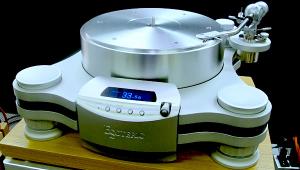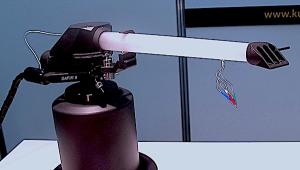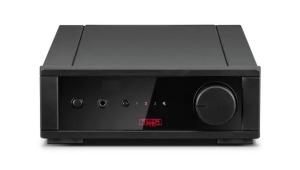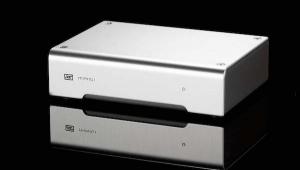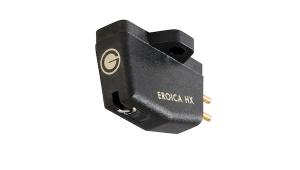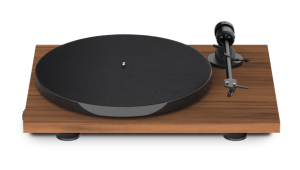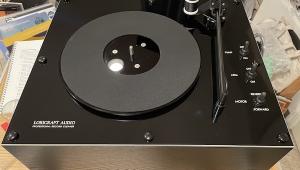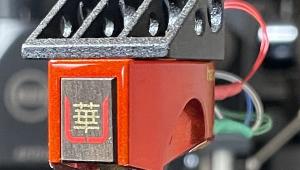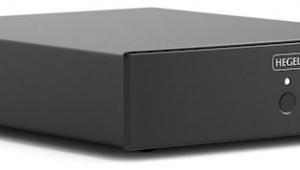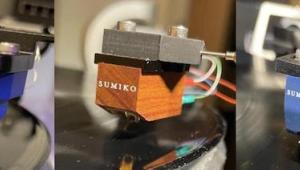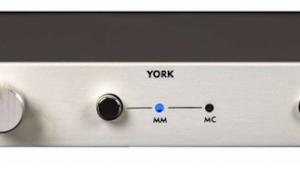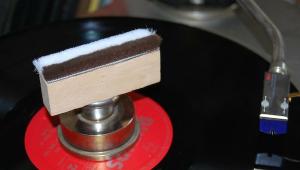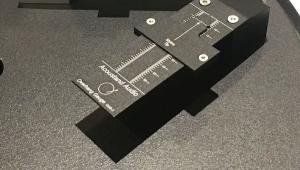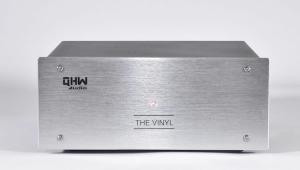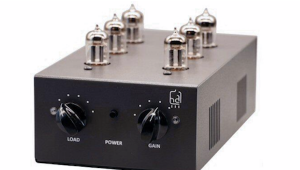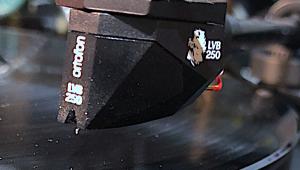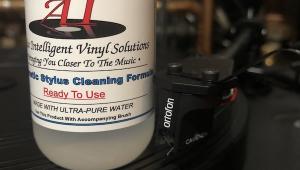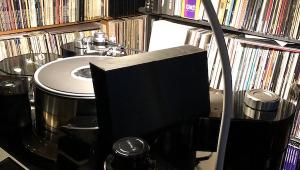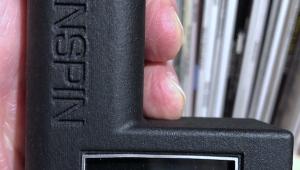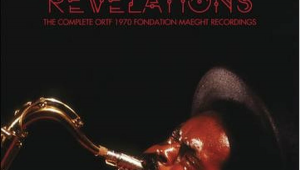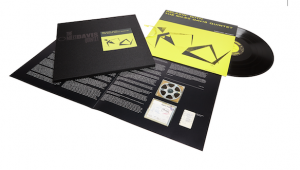European Audio Team C-Dur Turntable
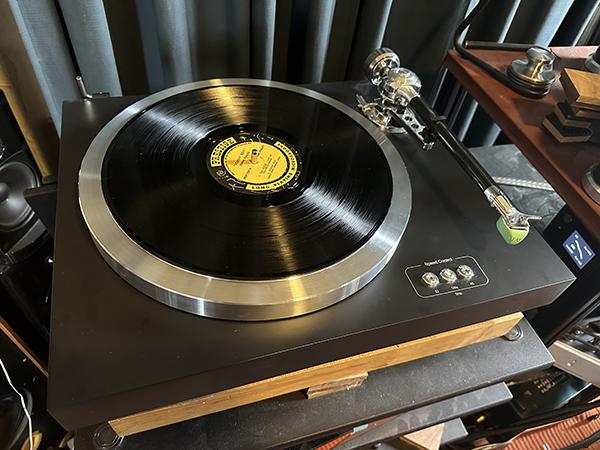
A close look at the lineup of turntables, amplifiers, and cartridges available from Austrian manufacturer European Audio Team — perhaps better known by their more precise acronym, E.A.T. — reveals beautiful electro-mechanical designs reflected in graceful lines, unusual exterior choices, and well-appointed materials that elevate the brand to stellar eye-candy status even before engaging the power button.
Beyond those good looks, E.A.T. has consistently delivered the sonic goods year after year and product after product, all from the brain of E.A.T. owner and CEO Jozefina Lichtenegger (née Krahulkova), who had a rich history in hi-fi — more specifically, with tubes — long before marrying Pro-Ject Audio System’s Heinz Lichtenegger and thus constituting one of the most business-savvy households in audio manufacturing.
While Pro-Ject makes no-nonsense, attractive equipment of their own and arguably owns the entry-level turntable lane (Rega Research notwithstanding), the singular design appeal of E.A.T.’s offerings is in a league of its own. True, E.A.T.’s lineup isn’t extensive — but it is impressive. The massive E.A.T. Fortissimo turntable features a brass-laden platter and dual-belt-drive design. Meanwhile, EAT’s sleek amplifiers and phono preamps — which truly look like no other, and never fall into the gauche camp — would look at home aboard 2001: A Space Odyssey’s Discovery One. Add in the company’s fancifully colored, highly rated, and sleekly shaped Jo No. 5 and Jo No. 8 moving coil (MC) cartridges, and you’ll find E.A.T. is wholly capable of matching outstanding design acumen with equally fantastic sound.
When I reviewed EAT’s KT-88 equipped, 35Wpc E.A.T. E-Glo I integrated amplifier for our sister site Stereophile back in December 2022, it earned my top rank as one of the finest integrated amps to ever grace my habitually kit-stuffed West Village, NYC listening locale. In that review, I noted of the E-Glo I, “In its ability to create a supercharged musical presentation within a large soundstage populated by big images, allied to superb definition and resolution, with good tone, the E.A.T. E-Glo I gets so many things right in such a balanced, forceful presentation that I'd say it's worth its asking price. Enthusiastically recommended.”
Will the subject of this review, the European Audio Team C-Dur turntable, meet the same magical fate via my writer’s grab-bag of rhapsodic prose? Let’s find out.
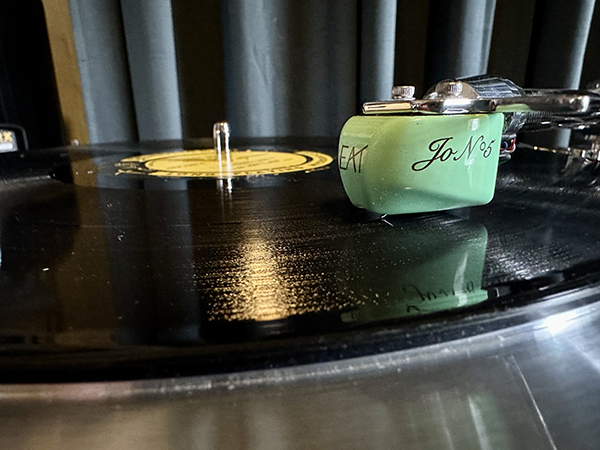
Features & Specs
We previewed the E.A.T. C-Dur ’table here back in early January, but here’s a refresher on its features and specs accordingly. Handmade in Europe, the E.A.T. C-Dur is built from sturdy, serious components that hopefully amount to sonic excellence. Among its features are (deep breath): the E.A.T. C-Note 10in carbon-fiber tonearm, lightweight aluminum headshell, fully adjustable VTA, 1.9lb (900g) resonance-free aluminum sub platter, 11.4lb (5.2kg) aluminum platter, 3.9 lb (1.8kg) mass-loaded bearing block, inverted main bearing with ceramic ball, 50mm MDF plinth, three adjustable conical damped aluminum feet, isolated motor, motor-controlled electronic speed change (33/45rpm), dustcover, included Audiophile 5P to RCA tonearm cable, and high-gloss plum and satin-black finish options.
Let’s now look at some of these features a little more closely. The belt-driven, 34lb C-Dur is based on a 50mm MDF plinth. The turntable’s heavy, 13.5lb platter has a sleekly elevated upper ridge, which holds an LP ever-so-slightly above the plane of the platter, with a 1in outer area of the platter exposed. The C-Dur’s oversized dimensions recall the transcription platters found on turntables in the 1940s, when radio broadcasts were recorded on 16in shellac, then played back on 16in players. The C-Dur platter’s Teflon thrust plate rests on a 3.9lb inverted bearing assembly with stainless-steel spindle and ceramic ball. The motor is fully decoupled, and an onboard AC generator maintains the C-Dur’s speed stability.
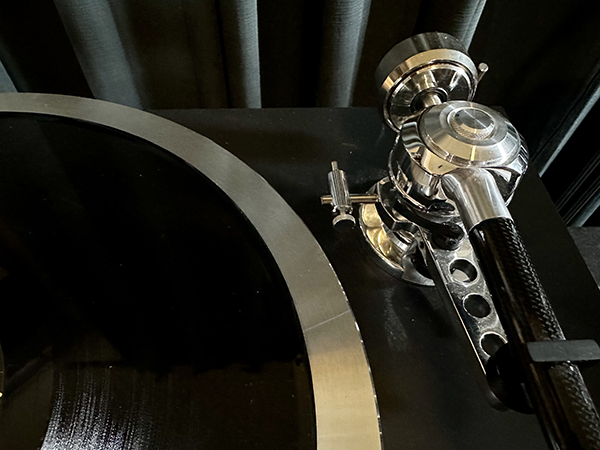
According to the E.A.T. site, “The 10[in] carbon E.A.T. C-Note tonearm combines all advantages of an unipivot arm with a Cardan joint. The unipivot in the middle lessens the load on the bearing, and the Cardan bearing ensures high stability and ease of use with very low friction. Inside the arm is a special silicon-based grease to damp resonance by more than 50%.”
The E.A.T. site posting continues, “The carbon tube offers stiffness. The aluminum headshell offers damping. Inside the tonearm is a special silicon-based grease to dampen the tonearm/cartridge resonances by more than 50%. A semi-balanced 5P DIN to RCA cable is included. Simply upgrade to a balanced phono cable for the benefit of fully balanced signal transmission.”
The beautifully constructed C-Note tonearm is easily adjustable, offering adjustments including VTA (vertical tracking angle), SRA (stylus rake angle), VTF (vertical tracking force), and azimuth, with a slotted headshell for overhang/offset angle.
“The anti-skate mechanism has been engineered for more intuitive calibration, making setup of the C-Dur notably easier than competitive products,” further states the site. (Me, I never use anti-skate because, in my experience, it tends to affect the sound for the worse.)
“The table’s low-noise synchronous motor is isolated and placed into a steel ring which is mounted in the chassis,” speaketh the site. “An external DC power supply unit with an AC generator creates a completely clean power for the motor. A special anti-static polished rubber belt connects the motor with the sub-platter.”
E.A.T. claims the “motor was integrated into the chassis of this turntable in such a way that it is de facto completely decoupled, and therefore not the slightest vibration can negatively affect playback.” The motor seems hidden in a black aluminum block that’s located on the left underside of the table.
The E.A.T. C-Dur turntable is available in four different packages — and thus, sports four different SRP options. The satin-black finish C-Dur has an SRP of $3,799 without the cartridge, while the satin-black finish C-Dur with the E.A.T. Jo No. 5 moving coil (MC) cartridge runs $4,599 — and that’s the version supplied for this review. The high-gloss plum finish edition of the C-Dur runs $4,499 without the cartridge, while the high-gloss plum finish version of the C-Dur with the E.A.T. Jo No. 5 MC cartridge goes for $5,299.
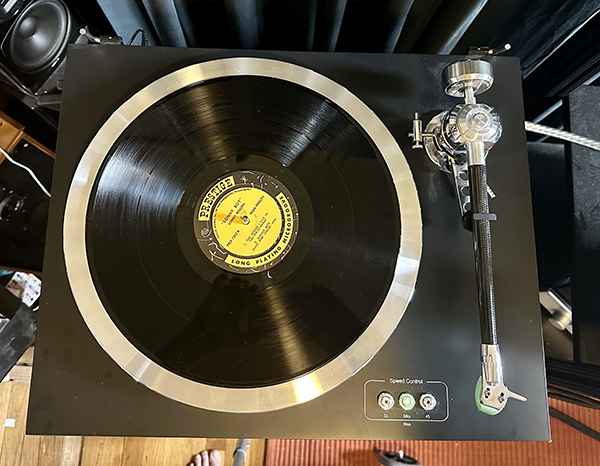
Setup
Though closer to matte black than the satin-black finish advertised, the E.A.T. C-Dur turntable arrived practically as a plug-and-play unit. I only needed to remove a few pieces of wrapping wire from the tonearm and set the platter and belt. The Jo No. 5 MC cartridge alignment was preset, and I checked tracking force with my Riverstone Audio Record-Level VTF gauge.
That said, the maddening part of this C-Dur set-up sequence came via the included “semi-balanced 5-pin DIN to RCA cable,” which locks into a connecting receptacle on the bottom of the table. When I consulted the manual, I found it wasn’t clear that I had to insert the cord into the bottom of the table until it was otherwise entirely set up. No matter how much I tried, I could not get the DIN plug to connect. I literally spent two hours trying to do it and then I gave up, defeated and spent — until I had an idea. I reached out to Steve Cohen, formerly of NYC’s In Living Stereo, who generously came over and cinched it in 20 minutes. Moral of the story: sometimes you do need a professional!
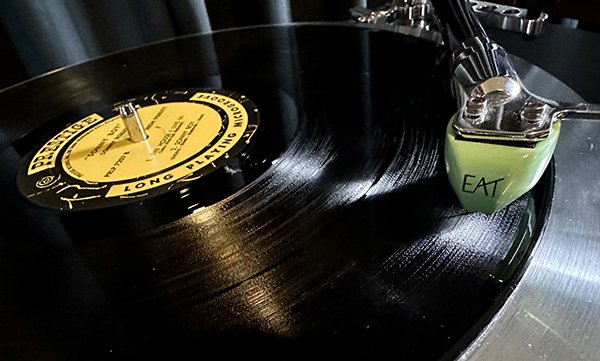
I enlisted an assortment or gear for this C-Dur review, including Audioquest Pegasus ZERO-Tech analog interconnects ($1,435/pr), of which helped topple my prior, les-than-stellar impressions of this venerable cable brand. In the past, it seemed to me AQ ICs/speaker cables were either too bright, unnatural, and/or thin-sounding, regardless of model. Treble seemed especially noticeable within the frequency range, for example. Thankfully, these Pegasus ZERO-Tech ICs changed all that, as excellent resolution, force, and soundstage depth were allied to a touch of warmth and sweetness. Overall, the sound was more hi-res, smooth, and informative with excellent resonant capabilities, drawing reverb tails and ambient cues I didn’t know existed. After a little burn-in time, these AQ cables outperformed all ICs I currently have in-house, easily.
Also in use during this C-Dur review were the Gold Note PH-5 phono preamp, PrimaLuna EVO 400 integrated amp, Triode Wire Labs Spirit interconnects, Analysis Plus speaker cables, and Harbeth SHL5plus XD stand-mount loudspeakers. I set the Gold Note PH-5 to the recommended >20ohm load setting of the E.A.T. Jo No. 5 MC cartridge and dialed in 2.4g on the tonearm, using my above-noted Riverstone Audio VTF gauge.
And with that, it was time to listen.
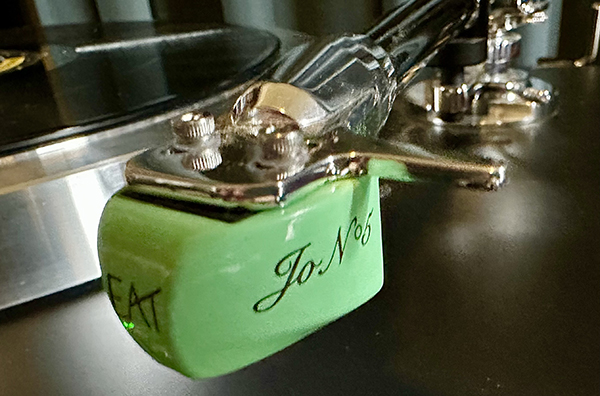
Listening Sessions
I began my evaluation with three albums that cut across genre, production, and era timelines. First, Steely Dan’s June 2003 release Everything Must Go (Reprise 9362-48435-1) is chock-full of Walter Becker and Donald Fagen’s characteristic wit, brevity, and jazz-spiced tune-ology. Next, the fragrant organ and rhythm box mastery of Mamman Sani’s 2014 release Taaritt (Sahel Sounds SS-023) is a pure time-traveling device, with Nigerien-Ghanaian keyboardist Mammane Sanni Abdoulaye’s flowing electronic organ rhythms adorning spicy drum-strings-percussion accompaniment, traveling a unique journeyman’s path of desert sand dunes and lost caravans. Finally, pianist Niels Lan Doky’s 1987 classic The Target (Storyville SLP 4140) romps a swinging path, with master musicians including double bassist Niels-Henning Ørsted Pedersen and drummer Jack DeJohnette laying down a festive stew of sparkling rhythm and grooves over the pianist’s buoyant melodies.
To cleanse my palette before diving into further evaluation, I also cued up these three albums on a VPI Avenger Direct turntable fitted with a VPI FatBoy gimbal tonearm with VPI Shyla MC cartridge. Though the E.A.T. C-Dur turntable and E.A.T. Jo No. 5 MC cart combo didn’t exactly match the overall performance of the VPI, it held its own surprisingly, even shockingly well. While there was a general overall lack of soundstage balance and depth compared to the VPI, and while it couldn’t approach the VPI’s supremely extended and detailed top end, the E.A.T. C-Dur didn’t lack for punch, force, or dynamics in comparison. It offered a slightly darker tone overall, as if its tonal center of gravity was lower. Its soundstage was wide and deep, if less dimensional than the uber-priced VPI.
The C-Dur’s low end was strong and deeply funky on the Steely Dan LP, and it also brought out all the wiry acoustic fluidity of Ørsted Pedersen’s upright bass — as well as DeJohnette’s punchy, slap-down way with cymbals and toms — on Lan Doky’s The Target. Plus, it placed Mamman Sani’s Taaritt in a zone of perfect listenability, its dark tonality and wide-stage percussive effects draping the music over my listening room like a silk umbrella of sound.
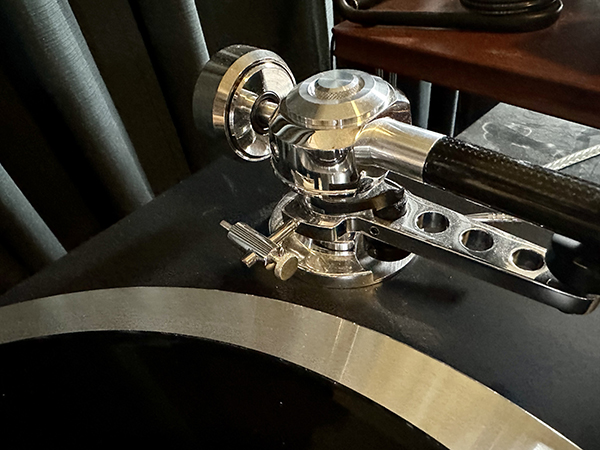
The C-Dur got up to playing speed in three seconds flat. Its cueing arm slowly lowered stylus to vinyl with undeniable fluidity, record after record. And for a belt-drive machine, its sense of pace, rhythm, and timing was superb. In this regard, it held its own equally well as the aforementioned direct-drive VPI Avenger Direct, with only the last 25% of force and drama MIA.
The C-Dur thoroughly engaged my listening senses with every style of music. It was also dead-transparent to recordings, exposing the slightly veiled haze of a fourth LP, Frank Zappa and The Mothers’ September 1973 masterpiece LP Overnite Sensation, not to mention the sparkling upper registers of The Target and the midrange-focused wonder of Taaritt.
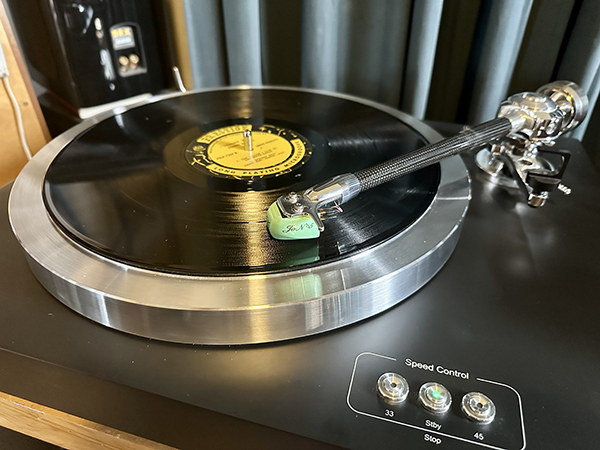
Conclusions
The European Audio Team C-Dur is, to my eyes, one gorgeous turntable. The oversized platter imbues a feeling of solidity and seriousness, while the chrome sections of the tonearm offset the darker finish of the carbon-fiber arm tube. And, mind you, its three control buttons are simple and direct.
The pale, cucumber-green finish of the striking E.A.T. Jo No. 5 MC cartridge provided a powerful, resolute, visceral, clear, spacious sound. It’s been praised by many a fine colleague out in the audiophile reviewing world — and now it’s my turn to add to the appreciative commentary cavalcade. Though the C-Dur ’table/Jo No 5 MC cart combo could occasionally sound hard on treble transients, it was record-dependent. If memory serves, the C-Dur may lack the drive of the Thorens TD 124 ’table, but it has perhaps a wider stage with better separation of vocals and instruments. Having reviewed the Clearaudio Concept Active Wood ’table elsewhere at $4,200 — and of course, there’s the Linn Sondek LP12, which runs $3,060 for the turntable only — the C-Dur-with-Jo No 5 combo fits comfortably in that neighborhood, one that is well beyond entry-level avenue and instead approaches the big guns cul-de-sac.
Like the E.A.T. E-Glo integrated amp I reviewed before it, the E.A.T. C-Dur turntable played by rules of its own making, and it came up golden. As if reinventing the sights and sounds of audio machinery for a target audience, the C-Dur is, above all, an exceptional music-reproducing machine that sounds natural, nuanced, detailed, and widespan-terrific.
I could easily live with this C-Dur turntable — the same feeling I had with its E-Glo I integrated amplifier brethren. In short, Jozefina Lichtenegger has once again waved her magic wand with the C-Dur, spreading golden dust on her machines and all who listen to them. So, here’s to the European Audio Team C-Dur turntable, and all the ensuing listening pleasures that are sure to come with it.
For more about European Audio Team (E.A.T.), go here.
To find out where to purchase an E.A.T. C-Dur turntable, go here, and/or here.
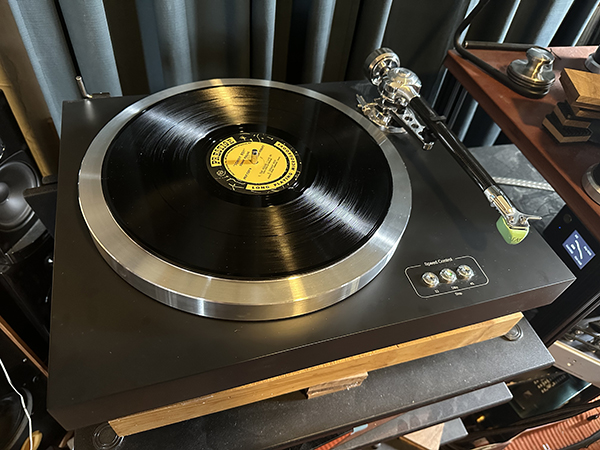
EUROPEAN AUDIO TEAM (E.A.T.)
C-DUR TURNTABLE
($4,599 as tested, with E.A.T. Jo No. 5 moving coil cartridge)
Specs
Nominal speeds: 33/45rpm
Speed variance: 33rpm: ± <0.08%; 45rpm: ± <0.09%
Wow & flutter: 33rpm: ± <0.01%; 45rpm: ± <0.01%
Signal to noise: –70 dB
Downforce range: 0-30 mN
Supplied counterweights: 5-13g cartridges
Effective tonearm mass: 16.5g
Effective tonearm length: 254mm
Overhang: 16mm
Power consumption: 8.5W max; 0.5W standby
Voltage: Universal power supply 15 V DC/1.6 A
Dimensions (w/h/d): 496 x 170 x 396mm (closed lid); 496 x 475 x 396mm (open lid)
Weight: 34.4lb (15.6kg)
